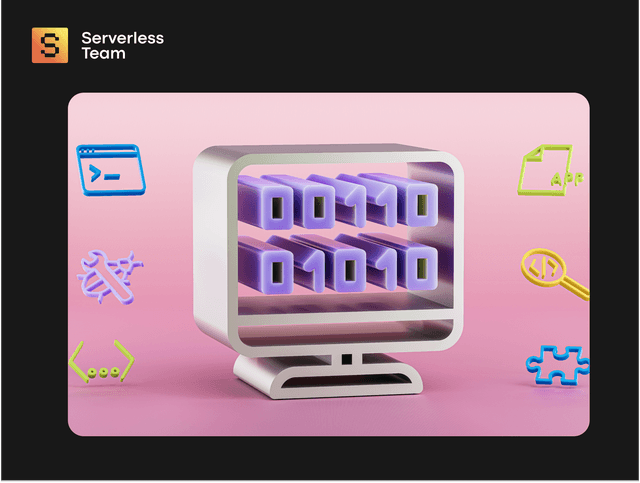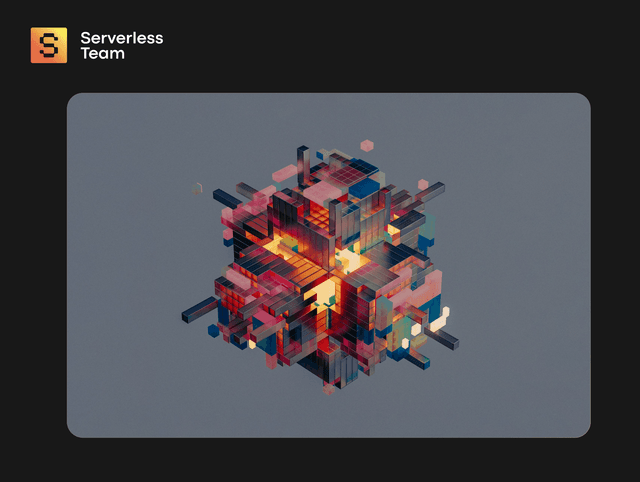Does adopting serverless tech feel a bit overwhelming with the various options available? Worry not! Our guide compares the two popular ones: Serverless Framework vs. AWS SAM. Drawing on our decade-long experience in serverless architecture deployment, we’re here to make your choice a breeze, just as we did for MasterStream and ZERO5.
Using frameworks in serverless apps is crucial for making development smoother and resources more efficient. Picking the right one isn’t just about tech — it’s a strategic move that affects how well your serverless projects work. Why so? A suitable framework follows your unique needs and sets the stage for scalability, performance, and deployment.
This post will walk you through AWS SAM and Serverless Framework. We’ll cover everything from the pros and cons to features and the main differences between these serverless deployment leaders. Prepare to go into the essentials and chart the course for your serverless journey.

We take care of serverless development so you can focus on your business
Don't want to wait for our site launch? Let's talk about your idea right now.


Serverless Framework vs. AWS SAM: Both Approaches Explained
Before diving into the serverless tech headfirst, it’s critical to understand the tools at your disposal. Let’s start our guide with the fundamentals and define Serverless Framework and AWS SAM.
Serverless Framework Overview
Serverless Framework is an open-source platform that streamlines serverless app development. Built with Node.js, it’s like a bridge between your code and the cloud services necessary to run that code. Serverless was released in 2015 and has since split into two directions:
- Back end as a service (BaaS): This method is used to develop apps with cloud-based back ends.
- Function as a service (FaaS): This scenario involves executing the code in response to event triggers.
Initially developed for building apps on AWS Lambda, Serverless Framework’s capabilities go beyond just AWS. This tool works well with such FaaS providers as Azure Functions, Google Cloud Functions, Kubeless, Oracle Fn, and others. On top of that, this framework supports various plugins and handles app development of different complexities — from simple Lambda functions to complex multi-functional back ends.
AWS SAM Overview
AWS SAM, or Serverless Application Model, is tailored specifically for the AWS environment. Serving as an extension of AWS CloudFormation, this tool simplifies serverless app creation and Lambda functions execution. SAM comprises the two primary parts:
- AWS SAM templates: These are extensions to CloudFormation templates for serverless applications.
- AWS SAM Command Line Interface (CLI): This is a serverless app development and testing programming tool.
Additional components of AWS SAM are AWS CloudWatch events, DynamoDB tables, API actions, Amazon S3 objects, Amazon SNS, Amazon Kinesis objects, and Alexa Events.
While these two frameworks share similarities, like streamlining code execution and integration with AWS, they each boast distinctive features. Read on to learn more about those.

Kyrylo Kozak
CEO, Co-founderGet your project estimation!

AWS SAM vs. Serverless Framework: Features and Capabilities
Let’s now delve into the intricacies of Serverless framework vs. AWS SAM operation. Explore the main features of these solutions in the table below:
| Serverless Framework vs. SAM Feature Comparison | ||
|---|---|---|
| Feature | Serverless Framework | AWS SAM |
| Cloud providers available | AWS, Microsoft Azure, Google Cloud, Apache OpenWhisk, Oracle Cloud, Kubeless | AWS |
| Configurations format | Serverless Framework uses serverless.yml for configuration. | AWS SAM uses template.yaml for defining serverless resources. |
| Ecosystem | Serverless Framework has an extensive plugin ecosystem. | AWS SAM uses the AWS Serverless Application Repository. |
| GitHub | https://github.com/serverless/serverless (45.4k stars) | https://github.com/aws/serverless-application-model (9.1k stars) |
| Lambda functions | Serverless Framework supports AWS Lambda through API Gateway and other providers. | AWS SAM primarily focuses on AWS Lambda functions. |
| CloudFormation template deployment | Serverless Framework is not tightly coupled with CloudFormation. | AWS SAM natively integrates with AWS CloudFormation for deployment. |
| Abstraction built on CloudFormation | Serverless Framework creates an abstraction on a cloud service provider’s infrastructure. | AWS SAM builds an abstraction on CloudFormation. |
| Commands output | Serverless Framework generates more output of CLI commands. | AWS SAM delivers a more complex output of commands. |
| Shorthand syntax support | Serverless Framework doesn’t support shorthand syntax. | AWS SAM supports shorthand syntax. |
Serverless Framework vs. AWS SAM: Use Cases
Having reviewed the features of AWS SAM and Serverless Framework, let’s now explore the use cases of these tools.
Serverless Framework excels in the following applications:
- Websites and APIs: Serverless speeds up the development and deployment processes and allows developers to prioritize business logic over infrastructure management.
- Hybrid cloud and multi-language apps: Serverless enables programmers to build applications using different programming languages and cloud service providers.
- Continuous integration and continuous deployment (CI/CD): The plugin system and integration capabilities make Serverless Framework perfect for automating DevOps processes.
Similarly to Serverless Framework, AWS SAM works best in the following scenarios:
- Serverless web apps: AWS SAM builds web applications that scale dynamically based on demand.
- DevOps automation: Just like Serverless Framework, AWS SAM allows for efficient CI/CD processes.
Besides that, AWS SAM seamlessly integrates with all AWS services. This feature lets developers handle related components and resources within a single stack.
Serverless Framework vs. AWS SAM: Pros and Cons
Still hesitating about what’s best for your project: Serverless Framework or AWS SAM? We’ve got another comparison for you. Let’s look at these frameworks’ advantages and disadvantages so you understand your options better.
Pros and Cons of Serverless Framework
Dive deeper into our overview of the pros and cons of Serverless Framework. See the benefits of this tool first.
- Quick and simple deployment: Serverless Framework is easy to set up and allows you to deploy apps in as little as several days.
- User-friendly command lines: Serverless offers more straightforward command lines than SAM.
- Better scalability: Serverless architectures inherently provide scalability, enabling you to make changes whenever necessary.
- Increased flexibility: Serverless Framework adapts to shifting project requirements more easily than traditional methods.
- Detailed output: Serverless generates constant updates to the stack, making development and deployment more transparent.
- Active plugin community: Serverless Framework provides a plethora of plugins to expand its functionality.
Now, consider the downsides of Serverless Framework.
- Some plugins lack quality: While numerous plugins are available for Serverless Framework, some may be poorly made.
- Complex architecture: When looking at serverless vs. microservices, Serverless has a simpler architecture. Yet, this framework may still pose challenges for developers new to the tech. That's why they must know Serverless Architecture vs. Monolith Architecture and choose wisely.
- Testing difficulties: Testing serverless apps is challenging and takes time due to smaller integration units with FaaS compared to other architectures.
Pros and Cons of AWS SAM
Let’s proceed with our AWS SAM vs. Serverless Framework comparison by reviewing some of the benefits of SAM.
- Ease of use: AWS SAM is designed for simplicity, especially if you have experience in CloudFormation.
- AWS-controlled Lambda permissions: You don’t need to ask for Lambda permission when leveraging AWS SAM.
- Unified deployment configuration: SAM operates on a single AWS stack, allowing you to deploy all resources as a versioned entity.
- AWS dev tools integration: AWS SAM thrives from AWS tools for serverless app development.
- CloudFormation extension: AWS SAM leverages the power of CloudFormation for managing and deploying serverless applications.
Still, AWS SAM comes with certain drawbacks. They are as follows:
- Limited plugins: AWS SAM’s community of plugin creators is less diverse than the Serverless one.
- Swagger-based API gateway configuration: Developers may find it challenging to use Swagger.
- Relative newness in the market: Since AWS SAM is fairly new, it may contain bugs or potential limitations.
Serverless Framework vs. AWS SAM: Key Differences
Before you choose a relevant tool for your serverless project, discover the peculiarities of each. Let’s recap the difference between AWS SAM and Serverless Framework.
- Cloud providers: While AWS SAM focuses solely on AWS, Serverless Framework creates event-driven functions within different cloud services.
- CloudFormation: Serverless Framework and SAM both use CloudFormation, but Serverless is provider-agnostic, while SAM is AWS-specific.
- Local development and testing: SAM Local, integrating Serverless vs. Docker containers, allows for local execution of functions and API Gateway. Serverless Framework invokes Lambda functions from the command line as well, but it requires prior deployment to AWS and accessibility via API Gateway.
- Ecosystem: Serverless Framework allows you to access numerous plugins and surpass the CloudFormation capabilities. SAM, in turn, is limited to AWS tools.
You might also be wondering: How do I choose a suitable framework for my serverless endeavors? We’ve prepared a brief guide for such a case.
- Project scale and complexity: Consider your requirements carefully and note that Serverless Framework works well for different projects, while AWS SAM may excel in use cases of smaller scale.
- Ease of adoption: Both frameworks are user-friendly, yet Serverless may offer more straightforward commands than AWS SAM.
- Integration with AWS services: If having AWS tools at your disposal is critical for your project, then SAM may be a better choice.
- Development environment: Keep in mind that Serverless Framework is compatible with a wide range of dev environments, while AWS SAM works in AWS-centric settings. Evaluate which option is better for your particular case.
- Community support: If you appreciate the availability of resources and plugins, then Serverless Framework is the way to go. AWS SAM, still, offers a growing community of plugin creators.
- Vendor lock-in concerns: This is one of the Serverless architecture implementation issues you must avoid. Serverless Framework provides more flexibility in programming languages and cloud providers, while with SAM, you may be more tightly bound to the AWS ecosystem.
Regardless of your choice, Serverless Framework or SAM, both tools may suit your software needs.
Serverless Framework vs. AWS SAM: Community and Support
Community and support are critical aspects distinguishing AWS Serverless Framework vs. SAM. Explore the resources, forums, and additional tools available for each framework.
Let’s first discuss the Serverless Framework. The solution proudly claims adoption by 90% of all serverless apps. On top of that, it has already surpassed 164 million in downloads and gathered over 45k stars on GitHub.
This framework’s ecosystem is influential as well. Over 1,000 plugins add functionality to Serverless, and the most prominent of them are:
- Serverless Offline
- Serverless Webpack
- Serverless Prine Plugin
- Serverless Domain Manager
- Serverless HTTP
- Serverless Esbuild
The Serverless Framework’s dedicated GitHub repository contains the above plugins and beyond. It also offers comprehensive guidance on this tool’s proper implementation. Additionally, it provides developers with a Serverless Forums website, where they can discuss issues or find answers to their questions.
AWS SAM’s community, while still growing, already fosters collaboration and knowledge-sharing among developers. This tool gathered over 9k stars on GitHub and continues to expand its influence on serverless adepts.
AWS offers detailed documentation and over 600 free courses and learning plans for developers, cloud architects, and other specialists. AWS Serverless Application Repository contains more than 1,000 apps that help programmers expand the SAM’s capabilities. You can also join AWS SAM’s community on Slack to contribute to this tool’s progress further.
Our Team as Your Serverless Consulting Partner
At Serverless, we stand at the forefront of serverless consulting. Having accumulated over ten years of hands-on experience in the Serverless Framework, we’re here to navigate you through serverless tech’s intricacies.
Why partner with us? Here are several just compelling reasons:
- Future-proof solutions: Our experts think ahead of time and constantly monitor the latest trends and innovations in the serverless domain.
- Top-notch code quality: Writing clean and reusable code is our top priority.
- Transparent processes: Our goal is to make serverless consulting and development as clear as possible for you.
- Flexible approach: We swiftly respond to changes and readily accept alterations and improvements within the projects.
Witness our profound expertise firsthand and explore some of our successful projects.
MasterStream Monolithic Platform Redesign
MasterStream, a US telecom vendor, partnered with Serverless to modernize its platform and streamline supply chain processes. The client’s challenges included:
- Legacy monolithic platform needed more flexibility to meet evolving demands.
- Microservices integration for supporting asynchronous design
- Need for a robust and efficient database system capable of handling high volumes while ensuring consistency.
- The necessity of robust measures against DDoS attacks and other security threats.
Our Solution
With the help of the Serverless Team, the client has successfully transitioned to a serverless architecture with AWS. We implemented DynamoDB for scalable data storage, utilized API Gateway for RESTful APIs, and employed Amazon SQS for asynchronous communication.
Outcomes
The new architecture automated and simplified the supply chain, boosting performance, flexibility, and reliability.
- 14% increase in scaling capacity with automatic resource allocation
- Efficient data processing thanks to an optimized data model
- Relief from infrastructure management managed instances
- Enhanced protection against DDoS attacks.
ZERO5 Parking Service Modernization
Zero5, a parking automation service, partnered with Serverless to modernize its system architecture and technologies, focusing on improving speed, user experience, scalability, and security. The client aimed to overcome the following challenges:
- Decision-making between AWS SAM vs. Serverless Framework for architecture upgrades
- System architecture upgrade including features, scalability, user experience, speed, and security
Our Solution
With our help, the client successfully migrated to Serverless from AWS SAM, optimizing database queries and real-time updates. Architecture upgrades involved AWS CI/CD for automated stack creation, AWS Chime and Gateway WebSockets API integration, and enhanced security with Cognito.
Outcomes
Migrating the database from DynamoDB to AWS RDS enhanced data management scalability and structure, leading to significant improvements:
- Reduced project start time from several minutes to less than 20 seconds
- Decreased errors and bolstered data security
- Increased scalability
- Automated the deployment process.
As you can see, our team is dedicated to our clients’ success. Our extensive background allows us to transform the mere serverless experience into thriving ventures.
Conclusion
Choosing AWS Serverless Framework vs. SAM is crucial in your serverless journey. That’s because your project’s success depends directly on the foundation you set for it. We hope our guide has clarified things for you, covering these two frameworks’ pros and cons, features, differences, and considerations.
Serverless Framework, with its flexibility, scalability, and broad compatibility, pioneers the serverless landscape. On the other hand, AWS SAM, tied to the AWS ecosystem, provides a more focused approach.
Regardless of the framework you choose for your project, we at Serverless are here to help. Specializing in these technologies, especially building proof-of-concept IoT solutions with AWS, our experts can provide a detailed consultation to you for the AWS Cloud Application Development Services. Contribute to your serverless success story — contact our team today if you want to hire dedicated AWS developers.





